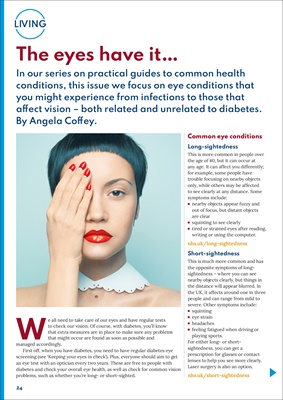
24
LIVING
The eyes have it…
In our series on practical guides to common health
conditions, this issue we focus on eye conditions that
you might experience from infections to those that
affect vision - both related and unrelated to diabetes.
By Angela Coffey.
Common eye conditions
Long-sightedness
This is more common in people over
the age of 40, but it can occur at
any age. It can affect you differently;
for example, some people have
trouble focusing on nearby objects
only, while others may be affected
to see clearly at any distance. Some
symptoms include:
nearby objects appear fuzzy and
out of focus, but distant objects
are clear
squinting to see clearly
tired or strained eyes after reading,
writing or using the computer.
nhs.uk/long-sightedness
Short-sightedness
This is much more common and has
the opposite symptoms of longsightedness
- where you can see
nearby objects clearly, but things in
the distance will appear blurred. In
the UK, it affects around one in three
people and can range from mild to
severe. Other symptoms include:
squinting
eye strain
headaches
feeling fatigued when driving or
playing sports.
For either long- or shortsightedness,
you can get a
prescription for glasses or contact
lenses to help you see more clearly.
Laser surgery is also an option.
nhs.uk/short-sightedness
We all need to take care of our eyes and have regular tests
to check our vision. Of course, with diabetes, you'll know
that extra measures are in place to make sure any problems
that might occur are found as soon as possible and
managed accordingly.
First off, when you have diabetes, you need to have regular diabetes eye
screening (see 'Keeping your eyes in check'). Plus, everyone should aim to get
an eye test with an optician every two years. These are free to people with
diabetes and check your overall eye health, as well as check for common vision
problems, such as whether you're long- or short-sighted.